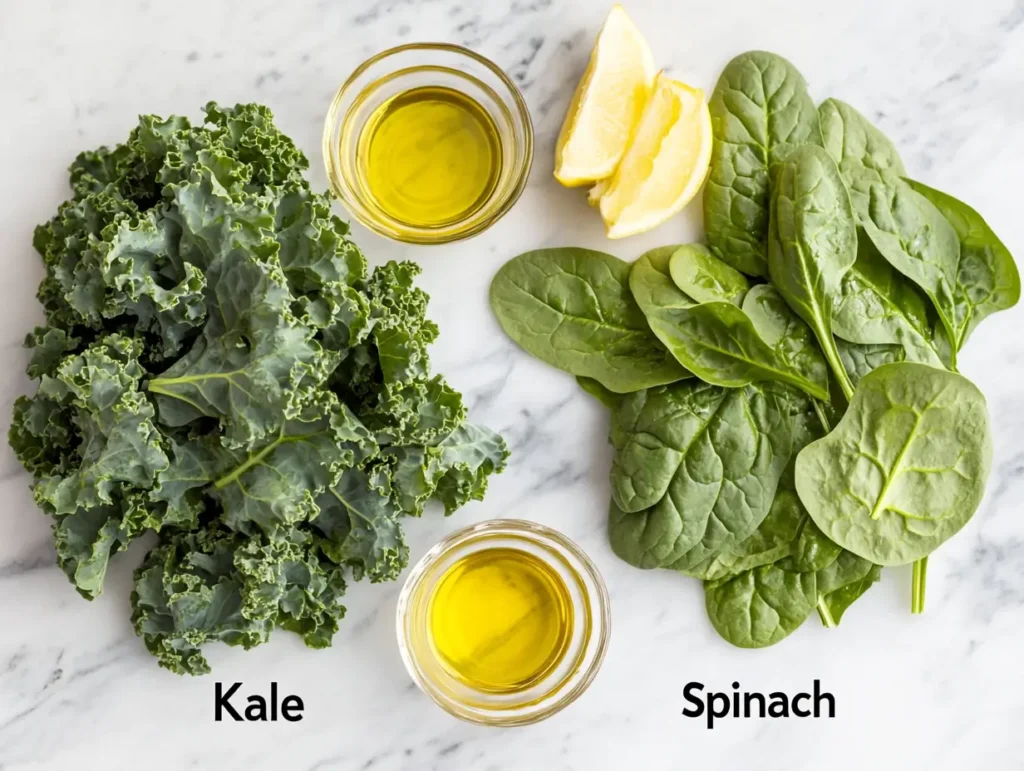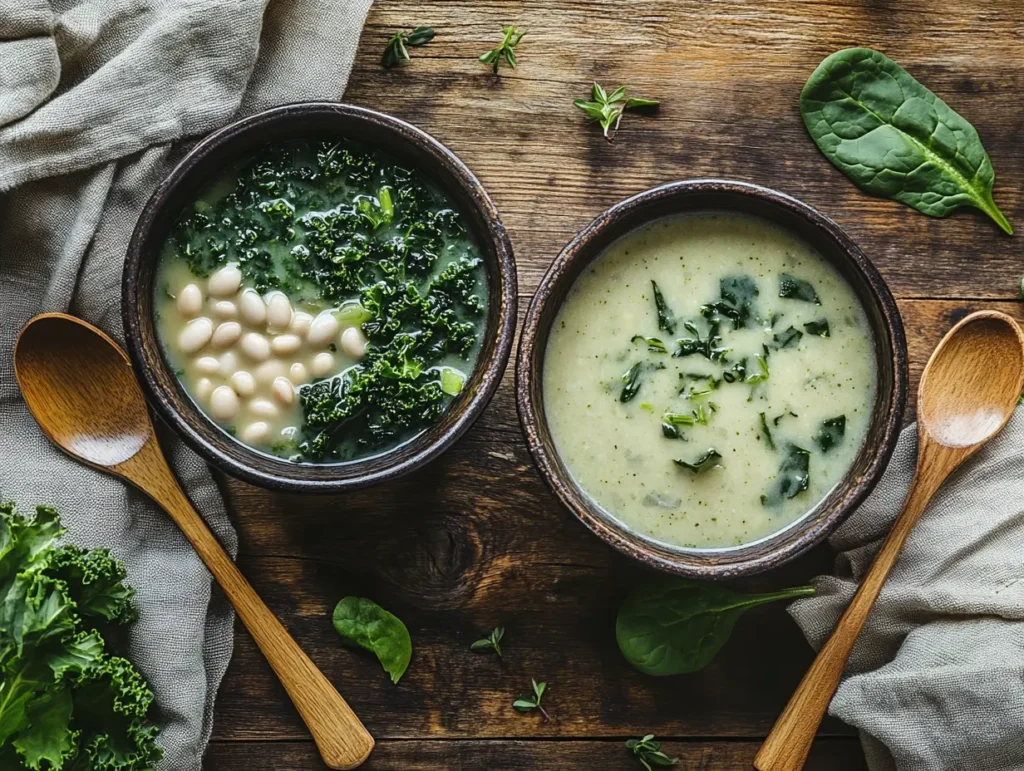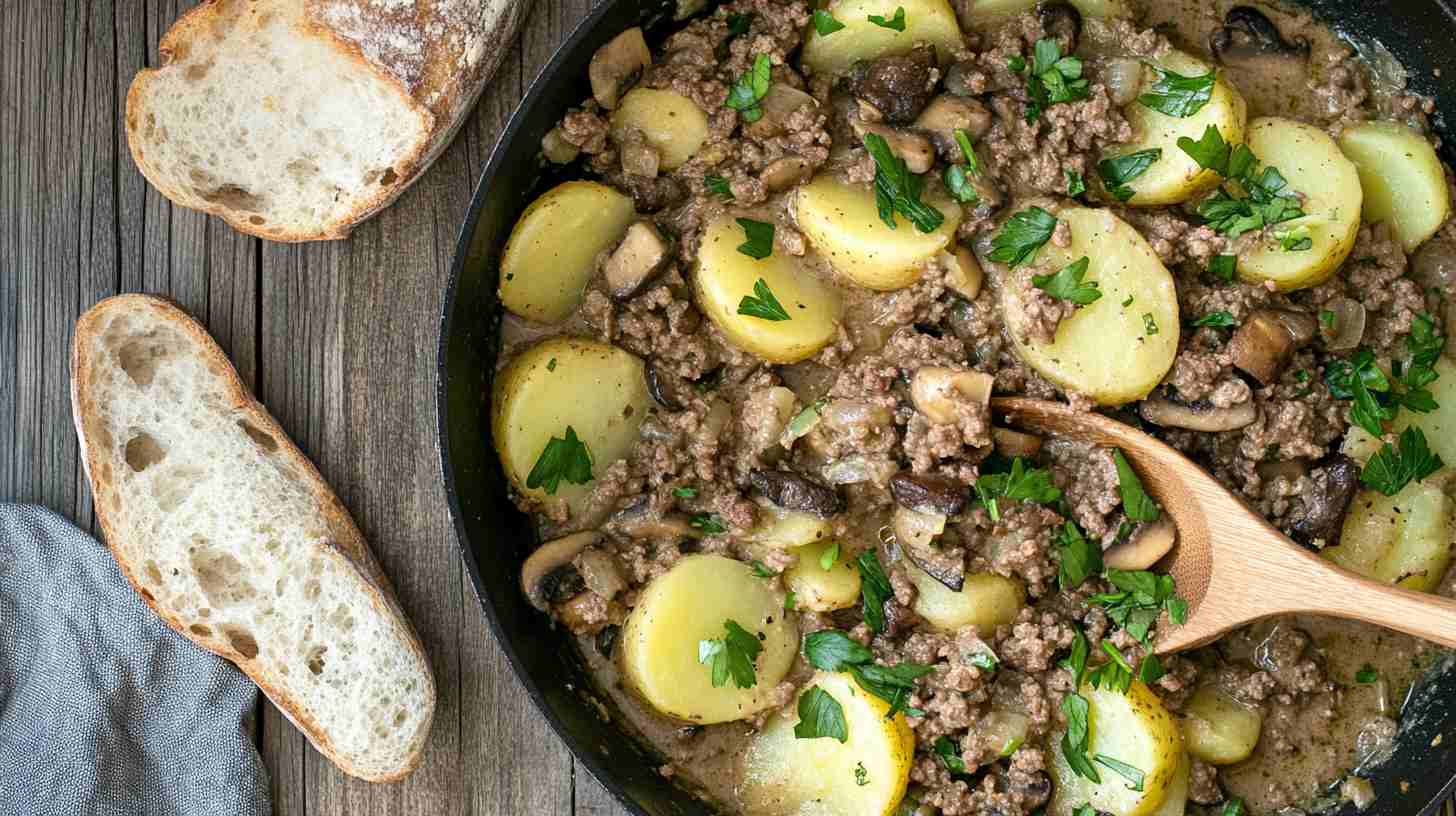When it comes to crafting the perfect bowl of soup, leafy greens like kale and spinach are often at the top of the ingredient list. These nutrient-packed vegetables are not only versatile but also incredibly beneficial for your health. However, a common question arises: which is better in soup, kale or spinach?
This article dives deep into the nutritional profiles, health benefits, and culinary uses of kale and spinach to help you make the best choice for your next soup recipe. Whether you’re looking for bold flavors, a silky texture, or a boost of vitamins and minerals, understanding the unique characteristics of these greens will guide you to the right decision.
For more inspiration, discover the versatility of soups with this unique French Onion Souffle recipe.
Nutritional Profiles of Kale and Spinach

Kale: The Nutritional Powerhouse
Kale has earned its superfood status thanks to its impressive nutrient profile. Here’s why it’s a favorite among health-conscious cooks:
- High in Vitamin C: Kale provides 80% of your daily vitamin C needs in just one cup, supporting immune function and aiding iron absorption.
- Rich in Vitamin K: This nutrient promotes bone health and helps with blood clotting.
- Fiber-Rich: Kale contains 2.5 grams of fiber per cup, aiding digestion and promoting gut health.
- Antioxidant-Rich: Kale is loaded with beta-carotene, polyphenols, and flavonoids, which help fight oxidative stress.
At only 33 calories per cup, kale offers a nutrient-dense option that is both filling and low in calories, making it perfect for soups aimed at weight management.
Spinach: The Iron-Rich Green
Spinach is another leafy green that brings a host of benefits to the table:
- Iron Content: Spinach is an excellent source of non-heme iron, crucial for red blood cell production.
- High in Folate: Folate is essential for cell regeneration and particularly important for pregnant women.
- Magnesium-Packed: Magnesium supports muscle function and heart health.
- Lutein and Zeaxanthin: These antioxidants protect eye health and may reduce the risk of cataracts.
With just 7 calories per cup, spinach is a low-calorie option that delivers significant nutrients without adding bulk.
Kale vs. Spinach: Nutritional Comparison
| Nutrient | Kale (1 cup, raw) | Spinach (1 cup, raw) |
|---|---|---|
| Calories | 33 | 7 |
| Fiber | 2.5g | 0.7g |
| Vitamin C | 80% DV | 9% DV |
| Iron | 0.9mg | 0.8mg |
| Folate | 19mcg | 58mcg |
Kale edges out spinach in fiber and vitamin C, while spinach wins in folate and magnesium. Choosing the right green depends on your specific nutritional needs.
Health Benefits of Kale and Spinach
Health Benefits of Kale
Kale’s nutrient-rich profile provides several key health benefits:
- Strengthens Bones: Kale’s vitamin K content is critical for calcium absorption, which promotes strong bones and reduces fracture risk.
- Boosts Immunity: Antioxidants and vitamin C in kale enhance the immune system, helping your body fend off illnesses.
- Cancer Protection: Glucosinolates, a unique compound in kale, may help protect against certain cancers.
If you’re looking for a recipe to enjoy kale, try this kale-focused soup recipe for a hearty, nutrient-packed meal.
Health Benefits of Spinach
Spinach offers equally impressive health advantages:
- Prevents Anemia: Its high iron and folate content help maintain healthy red blood cells.
- Lowers Blood Pressure: Magnesium in spinach relaxes blood vessels, supporting healthy blood pressure levels.
- Supports Pregnancy Health: Folate is essential for fetal development, reducing the risk of birth defects.
For a health boost, try this Ginger Turmeric Chicken Rice Soup that incorporates spinach into its nutritious blend.
Shared Benefits of Both Greens
Both kale and spinach contribute to overall health:
- Weight Management: Their low-calorie, high-fiber nature promotes satiety, making them ideal for weight loss diets.
- Rich in Antioxidants: Both greens combat oxidative stress, reducing inflammation and protecting against chronic diseases.
Culinary Uses of Kale and Spinach in Soups

Kale in Soups
Kale’s hearty texture makes it a fantastic addition to robust soups. It holds up well during long cooking times, making it ideal for recipes like:
- Kale and White Bean Soup: A filling, protein-packed option.
- Kale and Lentil Detox Soup: Perfect for a nutrient boost.
Spinach in Soups
Spinach is better suited for light and creamy soups. Its delicate leaves cook quickly and blend seamlessly into recipes like:
- Creamy Spinach and Garlic Soup: A velvety option with a hint of richness.
- Spinach and Lemon Orzo Soup: A bright, Mediterranean-inspired dish.
Combining Both Greens in Soups
For the best of both worlds, combine kale and spinach in your soup. Kale adds texture, while spinach contributes a smooth finish. Pro tip: Add kale early in the cooking process and spinach at the end to retain its vibrant color and delicate flavor.
Cooking and Storage Tips for Kale and Spinach
- Storage: Keep kale and spinach fresh by storing them in the refrigerator wrapped in a damp paper towel. They’ll stay fresh for up to five days.
- Cooking:
- Blanch spinach before adding it to soup to reduce its oxalate content.
- Massage kale leaves with olive oil before cooking to soften its texture and reduce bitterness.
- Freezing: Blanch and freeze both greens for up to six months. This method preserves nutrients and ensures they’re ready for soups anytime.
Potential Drawbacks to Consider
Spinach: High Oxalate Content
Spinach is high in oxalates, which can bind to calcium and form crystals, potentially leading to kidney stones in susceptible individuals. However, this drawback can be mitigated with proper preparation and pairing:
- Cooking Spinach: Cooking spinach significantly reduces oxalate levels by up to 87%.
- Pair with Calcium-Rich Foods: Foods like cheese or yogurt can help balance oxalate absorption.
For most people, spinach remains a healthy option when consumed in moderation and prepared appropriately.
Kale: Goitrogenic Effects
Kale contains goitrogens, substances that can interfere with thyroid function in large amounts. These effects are primarily a concern for individuals with existing thyroid conditions. To safely include kale in your diet:
- Cook Kale: Heat deactivates goitrogens, making cooked kale a safer choice.
- Moderation is Key: Eating kale as part of a balanced diet minimizes potential risks.
Flavor Profiles and Choosing the Right Green for Your Soup
Both kale and spinach bring distinct flavors to your bowl, allowing you to customize your soup based on your preferences:
- Kale: With its bold, earthy flavor, kale is ideal for hearty and rustic soups. Its texture holds up well in recipes featuring beans, lentils, and grains.
- Spinach: Spinach has a mild, slightly sweet flavor that works beautifully in creamy soups and brothy, Mediterranean-style dishes.
Choosing the Right Green:
- Opt for kale if you’re making a soup that requires long cooking times or bold flavors.
- Choose spinach for quick, delicate recipes that highlight fresh ingredients.
Recipes Featuring Kale and Spinach in Soups

Kale Soup Recipes
- Kale and Potato Soup: A creamy, comforting dish that pairs kale with soft, starchy potatoes.
- Spicy Kale and Lentil Soup: Add a kick of chili to complement kale’s robust flavor.
- Try this kale-focused soup recipe for a hearty, nutrient-packed meal.
Spinach Soup Recipes
- Spinach and Ginger Soup: A refreshing soup with subtle spice and a silky texture.
- Spinach and Mushroom Broth: Perfect for those who love umami-rich flavors.
- Boost your health with this Ginger Turmeric Chicken Rice Soup.
Combining Kale and Spinach in Recipes
- Kale-Spinach Minestrone: This Italian classic combines the heartiness of kale with the lightness of spinach for a balanced, veggie-packed meal.
Conclusion
Kale and spinach are both excellent choices for soups, each bringing unique nutritional benefits and flavors to the table. While kale excels in fiber and vitamin C, spinach shines with its iron and folate content. The decision ultimately depends on your taste preferences and health needs, but there’s no reason you can’t enjoy both in your cooking.
Incorporate kale into your hearty winter stews or detox-friendly meals, and let spinach shine in creamy soups and broths. Together, they can create a dynamic duo, offering the best of both worlds in a single dish.
FAQs
1. Is spinach or kale better in soup?
Both spinach and kale can be excellent in soups, depending on the type of soup you’re making:
- Kale is better for hearty, long-cooking soups because it retains its texture and adds a robust, earthy flavor.
- Spinach is ideal for light, creamy, or brothy soups due to its delicate flavor and quick cooking time.
Ultimately, the choice depends on the recipe and your taste preferences.
2. Is kale still healthy when cooked in soup?
Yes, kale remains highly nutritious when cooked in soup. Cooking can slightly reduce some heat-sensitive nutrients like vitamin C, but it enhances the bioavailability of others, such as antioxidants and glucosinolates. Kale’s fiber, vitamin K, and minerals like calcium and magnesium remain intact, making it a healthy addition to your soup.
3. Can spinach be substituted for kale in soup?
Yes, spinach can be substituted for kale in soup, but the texture and cooking time will differ:
- Spinach cooks much faster than kale, so it should be added toward the end of the cooking process to avoid overcooking.
- Spinach has a milder flavor, which might result in a less robust soup compared to one made with kale.
4. Which is healthier: spinach or kale?
Both spinach and kale are highly nutritious, but their strengths vary:
- Spinach is higher in iron, folate, and magnesium, making it excellent for blood health and pregnancy.
- Kale: Higher in fiber and vitamin C, offering more support for digestion and the immune system.
The healthiest choice depends on your dietary needs, but incorporating both ensures a variety of nutrients.






